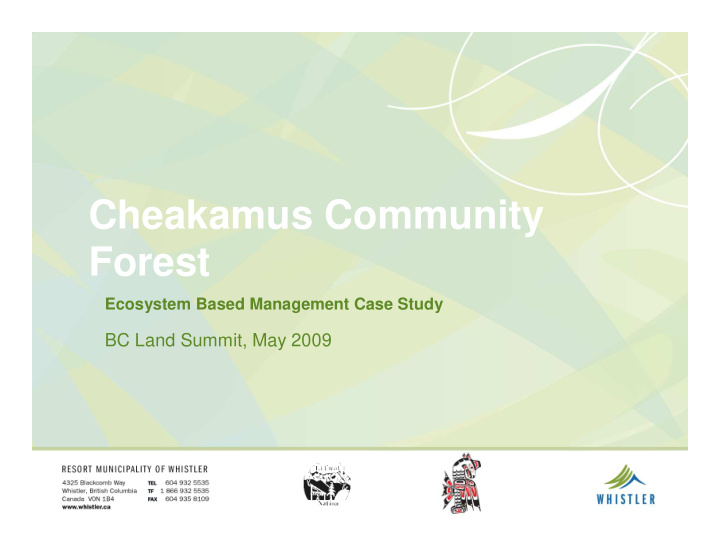



Cheakamus Community Forest Ecosystem Based Management Case Study BC Land Summit, May 2009
The Opportunity • BC Ministry of Forests Community Forest Program • Joint Partnership: Lil’wat Nation, Squamish Nation & Resort Municipality of Whistler • 20,000 m3 Annual Allowable Cut • Cheakamus Community Forest tenure signed April 9, 2009
The Land Base • Protected Area 14,983 ha • Managed Area – Old Growth 7,569 – Second Growth 5,671 – NSR 334 – Non productive 4,289 – Total 17,846 ha 32,846 ha • Total Land Base
The Goals • Ecosystem Based Management approach • Strengthened Relationships between communities • Employment & Capacity Building for First Nations • Public Education • Revenue to enhance the Community Forest
The Common Values �������������������������������������������������������������������������������� � � ���������������������� �������������� ����������������������� � ���������������������������� ����������������������������� ����������������������������� � ����������������������������� �������� ������������������������������ � ���������������������� � ���������������������������(���� ������ � � ����������������������� ���� ������������������ �������������������������������� � ������� ����������������������������� ������������������������� � ������������������������ ������������������������ ������������������������������� ������������������������� ����������� ������&)���������������� � � � ��� ������!"������#��������� ���������&��������������'� � ������������������������������ �������������������� ������������������������������� �������������������$���%������ ��������������������������� ����������� � ������������������������������ ��������������������� � � �
The EBM Approach So, what is Ecosystem Based Management? Coast Information Team definition …an adaptive approach to managing human activities that seeks to ensure the coexistence of healthy, fully functioning ecosystems and human communities.
The EBM Approach Ecotrust Canada (ecotrust.ca) Building the conservation economy in coastal BC The intersection of conservation and community economic development promoting innovation and providing services to green and grow local economies
The EBM Approach WHY EBM? Aligns with the partners’ existing land use plans and community values. Desire to move away from “business as usual” Forest Stewardship Council certification
The EBM Approach Challenges Moving to a fundamentally different management model Limited resources for implementation Dealing with complex systems
The EBM Approach 1. Identify current ecosystem representation & protected areas 2. Analyze seral stages of existing forest 3. Highlight sensitive ecosystems 4. Develop management directions
The EBM Approach And….. Integrating Human Well-Being Objectives of the three communities: – First Nations’ cultural values – Sustainability – Recreation – Visuals
The EBM Approach 1. Identify current ecosystem representation & protected areas at multiple scales. • Eco region • Eco section • Soo, Callaghan, and Whistler Landscape Units • Cheakamus Community Forest
C ultural M ana g em ent A reas S ho w h Lak es R ec. R eserve S 2S LR M P W ildlan ds U ngulate W inter R ange M ule D eer M ou nta in G oa t L egal O G M A R edlisted E cos ystem s* W etland s F luvial U nits* B luelisted E cosystem s* F ish stre am s & Lakes (b uffe re d) C heakam us C om m unity Forest
The EBM Approach 1. Identify current ecosystem representation & protected areas 2. Analyze seral stages of existing forest
The EBM Approach 1. Identify current ecosystem representation & protected areas 2. Analyze seral stages of existing forest 3. Highlight sensitive ecosystems
The EBM Approach Highlight sensitive ecosystems • Under-represented seral stages/BEC variants • Red & blue listed ecosystems and species • Riparian & aquatic habitats • Sensitive soils
The EBM Approach 1. Identify current ecosystem representation & protected areas 2. Analyze seral stages of existing forest 3. Highlight sensitive ecosystems 4. Develop management directions
The EBM Approach Management Direction Examples • All red-listed plant communities should be reserved from harvest. • Within blue-listed plant communities, 70% of the area should be reserved from harvest.
The EBM Approach Management Direction Examples • Within cutblocks, >15% of the basal area should be retained as long term structural diversity. • S1 to S3 fish streams and lakes should be buffered with a riparian reserve zone 1.5 times the height of the dominant trees.
A Variety of Approaches Mixed retention - - 19% 19% Mixed retention Group retention Group retention - - 13% 13% Group selection Group selection Mixed retention - Mixed retention - 16% 16% Two Two- -pass retention pass retention - - 53% 53% Standing stem harvesting Standing stem harvesting
A Variety of Approaches • How much and what pattern: landscape context, natural disturbance, riparian • Effectiveness for biodiversity: lifeboating species, structure, windthrow • Growth impacts: group vs dispersed • People factors: safety, costs, public acceptance
Adaptive Management A formal process for continually improving management practices by learning from the outcomes of operational and experimental practices. Bunnell et al. 2003
Adaptive Management Cycle Assess problem Design Adjust Implement Evaluate Monitor
Next Steps • Developing Targets for Seral Stage Distribution • Identifying the High Value Conservation Forests – i.e. Important Wildlife Habitat • Integrating the Human Well-Being Objectives of the three communities: – First Nations’ cultural values – Recreation – Visuals
Thank you
Recommend
More recommend